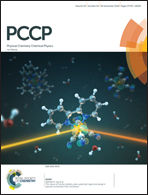Electronic structure and optical properties of novel monolayer gallium nitride and boron phosphide heterobilayers†
Abstract
Motivated by the increasing number of studies on optoelectronic applications of van der Waals (vdW) heterostructures, we have investigated the electronic and optical properties of monolayer gallium nitride (MGaN) and boron phosphide (MBP) heterobilayers by using first-principle calculations based on density functional theory. We have ensured the dynamical stability of the structures by considering their binding energies and phonon spectra. We show that the magnitude and status (direct or indirect) of the band gap are strongly dependent on the stacking pattern of the heterobilayers. Furthermore, we have investigated the band splittings in the presence of an external electric field which show the effect of the field on the band alignment of the structure. We have also shown the band gap, charge redistributions and work function of the structures are highly dependent on the magnitude and direction of the electric field such that its magnitude yields indirect to direct band gap transitions around |E⊥| ∼ 0.7 V Å−1 at the Γ point and the order of the band gap is varied according to the direction of the electric field. Moreover, we examine optical properties of MGaN/MBP heterobilayers as part of DFT calculations. The band gap and work function being tunable with changes in the external field together with the prominent absorption over the UV range make the MGaN/MBP heterobilayer a feasible candidate for optoelectronic applications.



 Please wait while we load your content...
Please wait while we load your content...